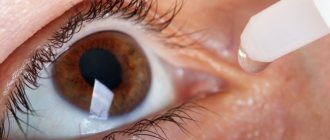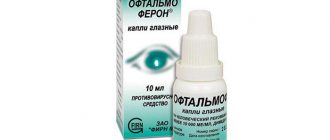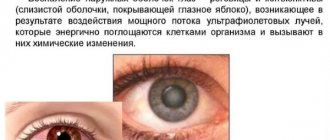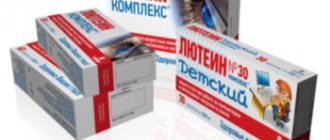Indications for use
Infection occurs when microbes appear in the eye area. Bacterial infection causes the appearance of stye, keratitis, conjunctivitis and other inflammatory diseases. Antibacterial drops are used to neutralize them.
Symptoms for which this medicine is prescribed:
- Pain in the area of the visual organ, constant desire to scratch the visual organ.
- Redness and swelling, not caused by anything. If a person sits at the computer all evening, and the next day his eyes acquire a reddish tint, then there is no need to sow panic. But if redness or swelling occurs for no apparent reason, there is an infection that needs to be treated immediately.
- A sharp decrease in vision.
- Eyes constantly water and react negatively to light. It is difficult to be in a bright room; the visual organ hurts and bothers the person. The release of tears when there is a sudden change in light. For example, when leaving a dark room into a light one;
- Purulent discharge.
If the above symptoms occur, you should immediately consult a doctor for treatment.
Antibacterial drops are also prescribed to prevent infections. Most often, in this case, they are prescribed to people predisposed to inflammatory processes. An example is a patient who constantly has problems with the visual organ, which is very sensitive to external influences. Weak in its structure.
Drops for conjunctivitis for children
For all the antibacterial drops mentioned above, one of the indications for use is acute conjunctivitis. In the presence of purulent discharge, it is recommended to use one of the broad-spectrum antibiotics ( Tobriss
,
Levomecitin
, etc.) or antiseptic drops (
Vitabact
,
Okomistin
).
For viral conjunctivitis, a combination of the antiviral drug Oftalmoferon
, with an antiseptic (
Ocomistin
,
Vitabact
), or with an antibiotic, since very often with a viral infection a bacterial infection is added on the 3-4th day of the disease.
For the allergic form of conjunctivitis, one of the antiallergic drugs is used, often together with the use of antihistamines orally ( Suprastin
,
Loratadine
,
Zodak
, etc.).
Classification of antibacterial drops
Classifies according to its effect on bacteria.
There are three types:
- They act destructively on the cell wall. The cell wall allows the bacteria to obtain nutrients. It determines the characteristics of the microorganism. If it is violated, the virus quickly dies.
- They affect the structure itself. When exposed to the structure, the bacterium is destroyed from the inside in a fairly short period of time.
- Slow down or completely stop the generation of nucleic acids. The production of new bacteria stops due to a disruption in the composition of the cell.
When choosing a type, you need to be guided by their contraindications. Each species has its own. It is better to consult an ophthalmologist for an appointment. If you make the wrong choice, there is a possibility of pathologies arising.
List for adults
Adult drops have different properties from children's formulations. Below we consider a list of the most popular drugs for adults.
Albucid
Antibacterial drops. They stop the reproduction of bacteria and disrupt its composition. After this, the cell stops its active life and gradually dies.
Albucid is prescribed two drops up to six times a day. When instilled, people feel a burning sensation, pain, and tears may flow. Cost – 20-50 rubles.
Oftadek
Used against microbes, fungus. It is not addictive, so it can be prescribed for a long period. It is considered one of the most effective antimicrobial agents. The cost of Oftadek is 50-70 rubles.
Levomycetin
Inexpensive but effective remedy. It is popular due to its low cost. Used for inflammation and infections. The cost of Levomycetin is 10-20 rubles.
Normax
Does not completely kill the microbe, but stops reproduction. After some time, the infection goes away on its own from the body. Instill Normax no more than five times a day. Costs from 120 rubles.
Azidrop
An effective remedy against a huge list of diseases. It is a universal medicine with a wide spectrum. Azidrop is also prescribed for the prevention of diseases. Instill once over several days. It has a number of contraindications and side effects. Use carefully to avoid problems. Cost – 300 rubles.
Sofradex
Contains an antibiotic. It is used not only for infections, but also for inflammatory processes. Indications: redness, allergies, irritation. It is not recommended to use for more than one week. Do not combine with other drugs. The cost of Sofradex is 320-340 rubles.
Tobropt
Antibacterial drops, which are prescribed for treatment and prevention of diseases after surgery. They are instilled depending on the severity of the disease. The cost of Tobropt is 100 rubles.
Vitabact
Used for many diseases. The duration of the course is no more than 10 days, since the drug can be addictive. The cost of Vitabact is 200 rubles. The choice must be taken seriously. Carefully study contraindications, action and application.
Carefully monitor your well-being after use. If side effects occur, stop use. Contact an ophthalmologist immediately. It is better to use drugs with a wide range of indications, so the risk of using the wrong drug is reduced.
Antibiotic treatment of various eye diseases
Quinolones, fluoroquinolones
A significant part of diseases is caused by bacteria of the genus chlamydia, strepto-, gono- and staphylococci. Other bacteria affect the eyes much less frequently, but are also capable of provoking purulent-inflammatory processes, causing pain, itching, burning, and lacrimation. Most often, patients are diagnosed with trachoma, various types of conjunctivitis, blepharitis, and keratitis. Conjunctivitis is much more often caused by viruses than by bacteria. Therefore, to prescribe adequate treatment, it is necessary to conduct tests to identify the pathogen.
Bacterial (and viral diseases complicated by a bacterial component) are successfully treated with antibiotics from the groups of fluoroquinolones, macrolides, and tetracyclines.
Eye drops with a broad-spectrum antibiotic are prescribed to prevent infection when removing a foreign body from the cornea or conjunctiva, in case of physical or chemical lesions, before or after eye surgery.
Antibacterial drops with fluoroquinolones have a wide spectrum of antimicrobial activity and are highly effective in most ophthalmic pathologies.
Uniflox, Floxal, Dancil® drops are made based on ofloxacin®. Normax® is made with norfloxacin, and Lofox® is made with levofloxacin. These drops help with chlamydial infections, blepharitis, conjunctivitis, keratitis, and ulcerative lesions of eye tissue. Ciprofloxacin in the form of drops is effective, among other things, against meibomitis and barley. Betaciprol®, Ciprolet®, Tsipromed®, Tsiprinol® and Combinil-Duo with dexamethasone® drops are available with ciprofloxacin.
Pack of Tsipromed® eye drops (ciprofloxacin 0.3%) 5 ml
Drops based on the active substances of the fluoroquinolone group are not prescribed to pregnant and lactating women and children under 18 years of age (with some exceptions) due to insufficient knowledge of their effect on the fetus and children's body.
Read further: Table of compatibility of antibiotics with each other
Macrolides
Antibiotics of the macrolide group are natural or semi-synthetic drugs. Macrolide antibiotics have low toxicity and are well tolerated by patients. They have the mildest effect on the body with at the same time a high therapeutic effect. Macrolides have few contraindications; they are approved for use by children. In some cases, the macrolide group is allowed for pregnant and lactating women.
The most effective are drops with azithromycin - Azidrop®.
Aminoglycosides
Brulamycin® based on tobramycin® gives excellent results. Effective for purulent inflammation; in small doses it inhibits bacteria, in higher doses it destroys them.
Main article: Classification of all aminoglycoside drugs and their complete list
Dexatobropt®, Tobradex®, Tobrazon® GCs are made from dexamethasone with tobramycin, a strong aminoglycoside antibiotic. They act even in severe advanced inflammation and relieve pain well, eliminate swelling, and contribute to a more rapid restoration of normal eye functions.
Antibiotics with tobramycin® are allowed for children from two months with mandatory supervision by a pediatrician. Drugs containing dexamethasone® are approved for use in the treatment of children over one year of age.
Gentamicin® in the composition of HA (gentamicin®, gentamicin-ferein®), in addition to the infectious and inflammatory diseases listed above, helps with inflammation of the iris (iridocyclide) and lacrimal sac (dacryocystitis).
Dex-gentamicin® includes dexamethasone®, which relieves swelling, inflammation and pain; the indications for its use are the same as for other gentamicin drops. Maxitrol® and Dexona® are produced with neomycin, eliminating swelling of the eyelids and periocular tissues, relieving pain and inflammation. Netilmicin® is the active aminoglycoside substance of nettacin drops.
Levomycetins
In the group of chloramphenicols, eye drops of the same name are produced. They are based on chloramphenicol and are effective against conjunctivitis, blepharitis, and keratitis. Boric acid, a disinfectant that increases the antibacterial effect of drops, is added to chloramphenicol-dia®, chloramphenicol-ferein® and chloramphenicol-akos®.
For diseases caused by bacteria resistant to the above drugs, Fucithalmic® is prescribed based on the natural antibiotic - fusidic acid. It is especially effective for dacryocystitis.
Complex drops with two types of antibacterial substances (framycetin® and gramicidin) sofradex® - effectively act against inflammation of the conjunctiva, iris, ciliary body, tunica albuginea, and episcleral tissue. The effect of Sofradex® is enhanced by dexamethasone.
Sofradex® eye drops
The list of eye drops for conjunctivitis with an antibiotic looks something like this: floxal®, fucithalmic®, chloramphenicol drops, maxitrol®, gentamicin®.
Read further: Levomycetin® - instructions for use of tablets and drops
List for children
Children can be prescribed the same drugs as adults, but with a reduced dosage. There are a number of drugs that are aimed specifically at the children's body.
Fucithalmic
Used for inflammatory processes. The peculiarity is that the medicine does not contain contraindications. Contains substances that do not cause allergic reactions.
Available for use by babies from birth. Premature newborns should not use these drops. The cost of Futsitalmic is 250-300 rubles.
Phloxal
It is prescribed both for infectious and inflammatory processes, and for the prevention of diseases. Not addictive. Instill two drops of Floxal no more than four times a day. From 150 rubles.
Maxitrol
A hormonal bactericidal agent that contains an antibiotic. The effect is felt after just a few uses. The cost of Maxitrol is 300 rubles.
Sodium sulfate
You can put the solution in the eyes of babies from birth. Use only 10% sodium sulfate. Safe and effective.
Consult your ophthalmologist for use in children. Without the appointment of a specialist, children are prohibited from using all types of drips, as this can have a detrimental effect on the baby’s body.
We recommend reading: How to put drops in a child’s eyes
Rules for taking antibiotics for the eyes
Regardless of the routes through which the medicine enters the body, a number of rules must be followed to avoid undesirable consequences and complications of the disease.
- If the use of several drugs is prescribed, then at least 15 minutes should pass between instillations. Then the drug will be completely absorbed and will not react with the next medicine.
- Taking it even in the form of drops is not compatible with alcohol.
- If a fungal infection begins to develop while taking antibiotics, you should consult an ophthalmologist about prescribing antifungal drugs: nystatin®, fluconazole®.
A short video about the correct instillation of eye drops:
Anti-inflammatory drops with antibacterial effect
Drugs are prescribed for infections aimed at the visual organ. Anti-inflammatory drugs are also used for viruses in which the eye is not the main target of infection (measles, rubella, chickenpox).
This type is aimed at producing a special substance that improves immunity and forces the body to fight the inflammatory process.
If antibacterial drops are aimed at destroying bacteria, then anti-inflammatory drops increase immunity and encourage the body to fight foreign antibodies.
Aktipol
It is used only if there are antibodies in the body that reduce immunity. A good antivirus product. Can be prescribed to people working with radiation. Protects against radiation. It is possible to combine with other drugs. The cost of Aktipol is from 100 rubles. The exact price depends on the region in which the medicine is purchased and the pharmacy chain.
Oftan I'm coming
Used for keratitis, keratoconjunctivitis, herpes. It has a number of contraindications. In particular, it should not be used by pregnant women. The course of treatment is up to 2 weeks. The cost of Oftan Idu is 150-200 rubles.
Oftalmoferon
Broad spectrum product. Acts as an antiviral, analgesic and anti-allergenic drug. Its effect is felt within a few minutes after instillation. It contains a large list of side effects, so you need to take the product strictly with the indicated dosage. The cost of Oftalmoferon is 300-500 rubles.
Hormonal drops
Drugs from this series are prescribed only for severe pathologies when other drugs do not help. The mechanism of their action is associated with influence at the cellular level. After use, the product is quickly absorbed, reduces the activity of immune cells, thereby reducing the severity of inflammation. However, the use of hormonal drugs is associated with the development of various negative phenomena.
Long-term treatment with such drugs leads to the development of cataracts or glaucoma. The described drugs do not help with bacterial, fungal and viral infections.
Hormonal drops are not used in children under 7 years of age.
The main active component of hormonal drops is corticosteroids. The most common ones are:
- Prednisolone
. Quickly relieves inflammatory processes in the structure of the anterior part of the eye and requires regular monitoring of intraocular pressure. The drug has a wide range of contraindications. - Dexamethasone
. Effectively copes with inflammation, but has no effect on the herpes virus. Do not use drops on contact lenses. You can put on your optics only half an hour after the procedure. - Prenatsid
. Reduces the permeability of the vascular network of the eyeball, stabilizes lysosomes. Intended for the treatment of non-infectious inflammations, used in the treatment of the posterior part of the eye. - Betamethasone
. Helps cope with viral conjunctivitis, facilitates healing after eye surgery. Long-term use leads to thinning of the sclera.
There are also hormonal drops that help eliminate inflammation caused by an allergic reaction. Such drugs do not affect bacteria, viruses and other pathogenic microorganisms.
Rules for using drops
It must be remembered that the effectiveness of use depends not only on the chosen product, but also on the correctness of its application. Recommendations for treatment can be obtained during a consultation with an ophthalmologist.
There are several rules that, if followed, will not cause harm:
- Before instillation, you must wash your hands thoroughly with soap to avoid infection. Do not touch your eyes with dirty hands. If they seem clean, you still need to wash them with the product.
- After opening the bottle, check for damage to the pipette. If the pipette is damaged, then it is better not to use such a product or use it with extreme caution. Increases the likelihood of mechanical damage.
- You need to choose a comfortable position for your fingers. Usually the bottle is held with the thumb and forefinger. This makes it easier to squeeze out the medicine.
- Under no circumstances should the pipette touch the mucous membrane, as this will introduce infection into the bottle itself. There is no benefit to such instillation.
- Take a comfortable position: lie on the bed or simply throw your head back. When instilling, you need to look up.
- Push back the lower eyelid with your fingertips. You need to act carefully so as not to damage the visual organ.
- Bring the bottle closer to the eye and drop the required amount.
- Close your eyes and lie there for a couple of minutes. For even distribution, lightly press the inner corners.
- Repeat the procedure for the second eye.
If the instructions are followed correctly, the treatment will become effective, and the organ itself will not suffer any damage.
Reviews
Oleg: My eyes became inflamed and swollen, they burned and tormented me with pain. It's not a pleasant sight. I went to the doctor. I was prescribed Oftalmoferon. Dosage – 3 times a day. The very next day the swelling subsided and I began to feel much better. There were unpleasant sensations when instilling them. It burns and burns. But everything goes away in about 20 seconds. Pros: quick action, efficiency. Of the minuses, I would note the high cost.
Ekaterina: The baby was a month old when we were affected by eye problems. I immediately consulted a doctor. The doctor prescribed Fucithalmic. Although the dosage was prescribed, I still read the instructions. The medicine turned out to have no contraindications and a natural composition. It worked quickly and painlessly.
Nelly: After the operation, antibacterial drops were prescribed - Tobropt. I was pleased with the low cost (per package – 85 rubles). The drops are not felt at all on the eye. No pain, burning or irritation. The postoperative period was painless for me thanks to this drug.
conclusions
Antibacterial drugs are often used in ophthalmology. They are effective and safe when taken in the correct dosage and following safety precautions. It is recommended not to self-medicate. If problems arise, immediately contact an ophthalmologist. He will prescribe the drug, dosage and course of treatment.
Author's rating
Author of the article
Alexandrova O.M.
Articles written
2031
about the author
Was the article helpful?
Rate the material on a five-point scale!
( 4 ratings, average: 5.00 out of 5)
If you have any questions or want to share your opinion or experience, write a comment below.









